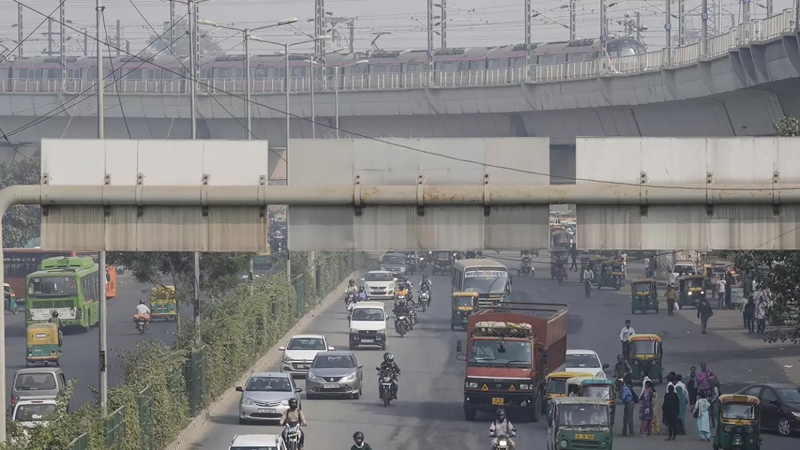NEW DELHI, July 8: An interaction between a western disturbance and monsoonal winds led to an intense rainfall spell over northwest India, including Delhi which experienced the season’s first very heavy rain and the highest in a day in 20 years, the India Meteorological Department (IMD) said on Saturday.
The Safdarjung Observatory, the city’s primary weather station, recorded 126.1 mm of rainfall between 8:30 am and 5:30 pm, the highest since the 24-hour rainfall of 133.4 mm on July 10, 2003, a senior IMD official said. The city logged an all-time high of 266.2 mm on July 21, 1958. The maximum temperature settled at 28.7 degrees Celsius, eight notches below normal.
The weather stations at Ridge, Lodhi Road, Pitampura and Delhi University recorded 128 mm, 118.2 mm, 83 mm and 86 mm of precipitation, respectively.
According to the Met office, rainfall below 15 mm is considered light, 15 mm to 64.5 mm is moderate, 64.5 mm to 115.5 mm is heavy, and 115.6 mm to 204.4 mm is very heavy. Any amount exceeding 204.4 mm is classified as extremely heavy rainfall.
The heavy rain submerged parks, underpasses, markets and even hospital premises, and created chaos on the roads. Pictures and videos of commuters wading through knee-deep water flooded social media, raising concerns about the efficiency of the city’s drainage infrastructure. Strong winds and showers also caused disruptions in power and internet connectivity in several areas.
The IMD said a Western Disturbance prevailed over northern India, while the monsoon trough extended to the south of its normal position, reaching lower tropospheric levels. Additionally, a cyclonic circulation was embedded over southwest Rajasthan.
This interaction between the western disturbance and monsoonal winds is expected to persist for the next 24-36 hours, leading to moderate rainfall inmost parts of northwest India, according to an IMD update issued around 4 pm.
With the showers bringing back the familiar scenes of waterlogged roads and long lines of vehicles stuck in the deluge, residents expressed anguish over Delhi’s “poor drainage system”.
“Delhi and entire NCR turns into a pool of water with just one hour of rain. Very poor drainage management. Very risky to venture out in rains. Apart from heavy waterlogging, there are so many potholes on roads to negotiate! (sic),” a Twitter user said. “Delhi is waterlogged after a heavy rain. The capital of India still lacks good roads, a decent drainage system, and proper infrastructure, even after 75 years of independence. We don’t need free electricity and water; we need better roads and drainage systems,” another Twitter user said.
Delhi has three major drainage basins: Najafgarh, Barapullah, and Trans-Yamuna. During rainfall, storm water on the eastern side of the central ridge directly flows into the Yamuna. On the western side, smaller drains merge into the Najafgarh drain, which eventually empties into the river.
The eastern region of Delhi is low-lying and was originally part of the Yamuna floodplain. The existing storm water drainage system in Delhi is prone to congestion, primarily caused by waste and sewage, leading to sluggish water flow.
Different parts of Delhi experience annual flooding due to factors such as excessive concrete structures, disappearance of water bodies, encroachments on the storm water drains, and the discharge of untreated sewage and waste. The management of the drainage system involves multiple agencies, further complicating the situation,according to the city government’s state action plan for climate change.
The last drainage master plan for Delhi was created in 1976 when the city’s population was approximately 6 million. With the current population of around 20 million, a new ‘Drainage Master Plan for NCT of Delhi’ was commissioned in 2012, prepared by IIT Delhi.
Although a final draft was submitted to the government in 2018,the plan is yet to be implemented. The state action plan for climate change identifies “heat waves and heavy precipitation events on fewer number of days” as two major vulnerability pain points. The IMD issued a warning of isolated extremely heavy rain in Himachal Pradesh and Uttarakhand throughout Saturday and Sunday.
Heavy to very heavy rain is predicted in isolated areas of Jammu and Kashmir until Monday, and in eastern Rajasthan, Haryana, Chandigarh, Delhi, and Punjab until Sunday. The IMD said heavy rainfall is unlikely in the region starting from July 11.
Delhi recorded above-normal rainfall in the last four months — 53.2 mm against a normal of 17.4 mm in March, 20.1 mm against an average of 16.3 mm in April, 111 mm against a normal of 30.7 mm in May and 101.7 mm against a normal of 74.1 mm in June. The city has gauged 164 mm of rainfall in July so far. On an average, the city receives 209.7 mm of rainfall in the entire month.
Meteorologists attributed the above-normal rainfall to higher-than-usual western disturbances– weather systems that originate in the Mediterranean region and bring unseasonal rainfall to northwest India — this year. Amid bountiful rains, the Safdarjung Observatory did not record any heat wave day in the summer season (April to June) this year for the first time since 2011.
The IMD has predicted normal rainfall (94 to 106 per cent of the long period average of 280.4 mm) in the country in July. However, it anticipates below-normal precipitation over many areas of northwest, northeast and southeast peninsular India. (PTI)


